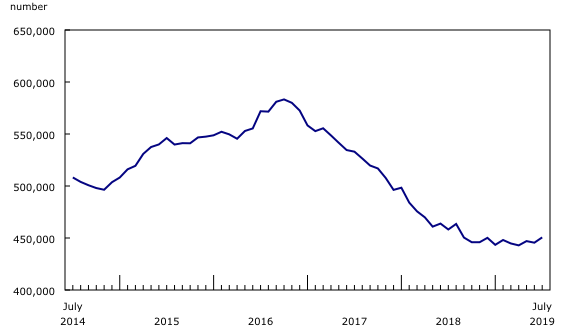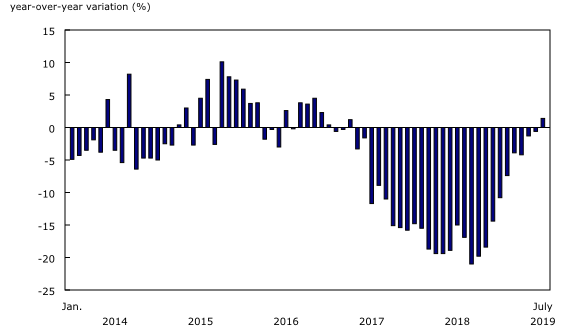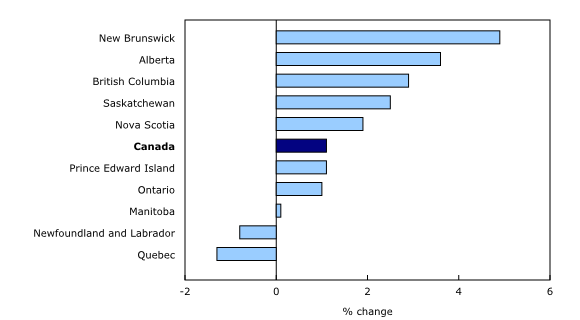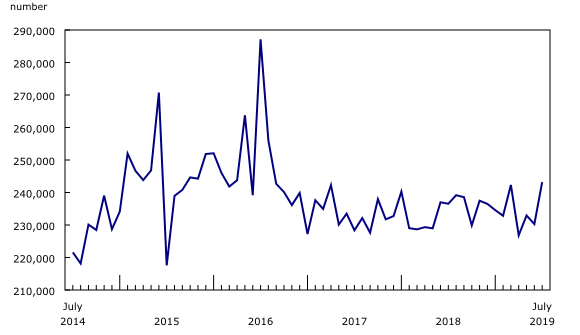Employment Insurance, July 2019
Archived Content
Information identified as archived is provided for reference, research or recordkeeping purposes. It is not subject to the Government of Canada Web Standards and has not been altered or updated since it was archived. Please "contact us" to request a format other than those available.
Released: 2019-09-19
In July, 450,600 people received regular Employment Insurance (EI) benefits, up 5,100 (+1.1%) from June. The number of EI beneficiaries increased in seven provinces, notably in New Brunswick and Alberta. In contrast, there was a decline in Quebec, while there was little change in Newfoundland and Labrador as well as in Manitoba.
On a year-over-year basis, the number of EI beneficiaries in Canada fell by 7,600, or 1.7%, with declines across seven provinces. The largest decreases were in Alberta (-2,700, or -5.2%), Quebec (-2,700, or -2.5%), and Newfoundland and Labrador (-2,100, or -6.1%).
In general, variations in the number of beneficiaries can reflect changes in the circumstances of different groups, including those becoming beneficiaries, those going back to work, those exhausting their regular benefits, and those no longer receiving benefits for other reasons.
Provincial and sub-provincial overview
In July, the number of regular EI beneficiaries in New Brunswick increased 4.9% to 29,400, following a downward trend that started in January. Increases were observed across the province, notably in the census metropolitan area (CMA) of Saint John (+16.2%) and in areas outside the CMAs and census agglomerations (CAs) (+4.5%). The Labour Force Survey (LFS) reported that the unemployment rate in New Brunswick increased 0.7 percentage points in July to 8.5%. Compared with July 2018, there was a 4.1% increase in the number of EI beneficiaries, driven by more recipients aged 55 and over (+10.2%). The unemployment rate for this age group increased 1.8 percentage points to 9.5% over the same period.
There were 50,400 EI recipients in Alberta in July, up 3.6% from June, the first monthly increase since February 2019. The rise was driven by those who last worked in education, law and social, community and government services occupations, who represented 8.0% of the total number of regular beneficiaries in the province in July. Increases were observed in the areas outside the CMAs and CAs (+5.8%) and in the CMAs of Edmonton (+3.1%) and Calgary (+2.9%). LFS data indicate that the unemployment rate in Alberta increased 0.4 percentage points to 7.0% in July. On a year-over-year basis, the number of EI recipients was down 5.2%.
The number of EI recipients in British Columbia totalled 42,500 in July, up 2.9% from the previous month. This is the largest monthly increase since July 2016 and the first significant rise in five months. Increases were observed in several CAs, led by Port Alberni and Prince George, in addition to areas outside the CMAs and CAs (+3.9%). Compared with 12 months earlier, the number of recipients rose 1.4%, the first year-over-year increase since April 2017.
In Saskatchewan, there were 15,400 beneficiaries in July, 2.5% more than in June. This is the first increase since January 2019. There were also notable increases in the CMA of Saskatoon (+5.5%) and in the areas outside the CMAs and CAs (+2.9%). On a year-over-year basis, the number of regular EI beneficiaries decreased 3.9%.
In July, there were 25,700 beneficiaries in Nova Scotia, up 1.9% from the previous month. Most of the increase occurred in the CMA of Halifax (+3.3%) and in the areas outside the CMA and CAs (+2.6%). Compared with July 2018, the number of beneficiaries in the province decreased 5.4%.
In Prince Edward Island, there were 7,600 regular EI beneficiaries, 1.1% more than in June. There were 4.2% fewer regular EI recipients in the province than in July 2018.
The number of beneficiaries in Ontario increased 1.0% to 120,200. There were increases in several CMAs, with a notable rise in Windsor (+10.0%), coinciding with a decline in employment in the manufacturing sector recorded in the LFS. There were also increases in London (+4.8%), Hamilton (+3.2%), and Toronto (+1.1%). Compared with 12 months earlier, the number of EI beneficiaries in the province was little changed.
In Quebec, the number of people receiving regular EI benefits was down 1.3% to 108,100. This decline was due almost entirely to a decrease in the number of beneficiaries in the CMA of Montréal (-2.1%). On a year-over-year basis, the number of EI recipients fell 2.5%. Based on results from the LFS, the unemployment rate in Quebec reached a historic low during the summer of 2019.
Claims increase in July
In July, there were 243,200 EI claims, up 5.6% from June. The number of claims provides an indication of the number of people who could become beneficiaries. Claims data pertain to initial and renewal claims received for any type of EI benefits, including special benefits.
The number of claims increased in nine provinces from the previous month, notably in Alberta (+13.4%) and Saskatchewan (+11.0%). At the same time, there was a decrease in claims in New Brunswick (-2.1%).
On a year-over-year basis, the number of claims at the national level was up 2.8%. There were increases in five provinces, led by Saskatchewan (+16.0%), Alberta (+15.6%) and British Columbia (+10.9%). Declines were observed in Prince Edward Island (-7.8%), Newfoundland and Labrador (-3.3%), and Quebec (-2.1%).
Sustainable Development Goals
On January 1, 2016, the world officially began implementation of the 2030 Agenda for Sustainable Development—the United Nations' transformative plan of action that addresses urgent global challenges over the next 15 years. The plan is based on 17 specific sustainable development goals.
Employment Insurance Statistics are an example of how Statistics Canada supports the reporting on the Global Goals for Sustainable Development. This release will be used in helping to measure the following goal:

Note to readers
Concepts and methodology
The analysis presented here focuses on people who received regular Employment Insurance (EI) benefits related to job loss. Claims data pertain to initial and renewal claims received for all types of EI benefits, including special benefits.
EI statistics are produced from administrative data sources provided by Service Canada and Employment and Social Development Canada. These statistics may, from time to time, be affected by changes to the Employment Insurance Act or administrative procedures.
Regular EI benefits are paid to eligible individuals who lose their jobs and who are available for and able to work, but cannot find a job. To receive EI benefits, individuals must first submit a claim.
EI statistics indicate the number of people who received EI benefits, and should not be confused with Labour Force Survey (LFS) data, which provide estimates of the total number of unemployed people. There is always a certain proportion of unemployed people who do not qualify for benefits. Some unemployed people have not contributed to the program because they have not worked in the past 12 months or their employment was not insured. Other unemployed people have contributed to the program but do not meet the eligibility criteria, such as workers who left their jobs voluntarily or those who did not accumulate enough hours of work to receive benefits.
All data in this release are seasonally adjusted. For more information on seasonal adjustment, see Seasonally adjusted data – Frequently asked questions.
Numbers in the Daily text are rounded to the nearest hundred.
The number of regular EI beneficiaries and the number of claims received for the current month and the previous month are subject to revision.
The number of beneficiaries is a measure of all people who received regular EI benefits from July 14 to 20. This period coincides with the reference week of the LFS. However, claims data are for the entire month.
Geographical definitions
A census metropolitan area (CMA) or census agglomeration (CA) is formed by one or more adjacent municipalities centered on a population centre. A CMA must have a total population of at least 100,000. A CA must have a population of at least 10,000. See Standard Geographical Classification 2016 – definitions for more information.
Next release
Data on EI for August will be released on October 24.
Products
More information about the concepts and use of Employment Insurance statistics is available in the Guide to Employment Insurance Statistics (73-506-G).
Contact information
For more information, contact us (toll-free 1-800-263-1136; 514-283-8300; STATCAN.infostats-infostats.STATCAN@canada.ca).
To enquire about the concepts, methods or data quality of this release, contact Valerie Gagnon (613-867-5782; Valerie.gagnon@canada.ca), Centre for Labour Market Information.
- Date modified:







